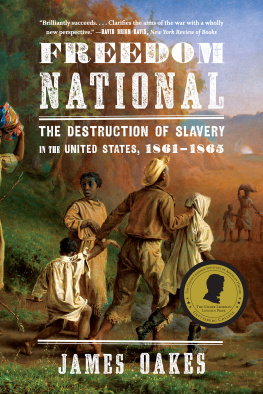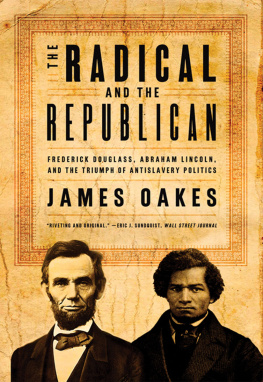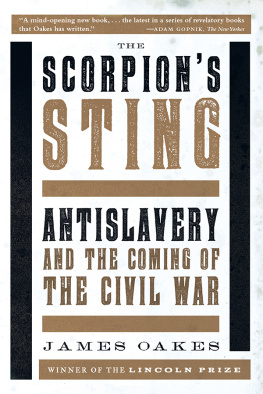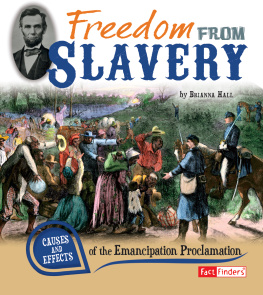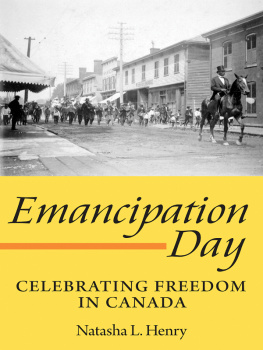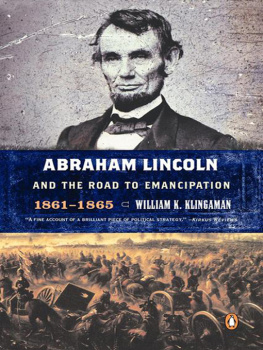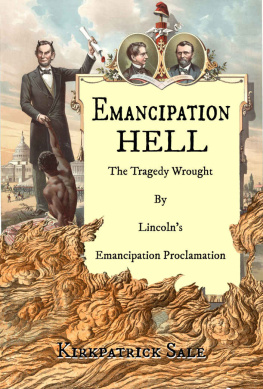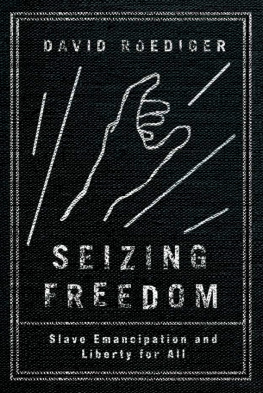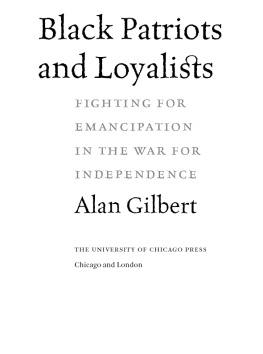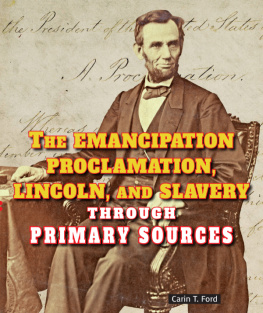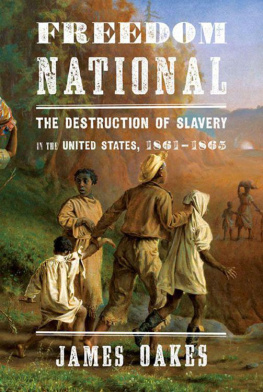

For
DEBORAH and DANIEL,
without whom, nothing
CONTENTS
The Radical and the Republican: Frederick Douglass,
Abraham Lincoln, and the Triumph of Antislavery Politics
Slavery and Freedom: An Interpretation of the Old South
The Ruling Race: A History of American Slaveholders
O N M ARCH 24, 1862, Illinois Republican Isaac Arnold introduced a bill in the House of Representatives that would render freedom national, and slavery sectional. Isaac Arnolds bill was the lineal descendant of that tradition, and in it lay the origins of the Republican Partys antislavery policies during the Civil War.
Tracing the historical origins of a policyor a war, or almost anythingalways risks making it look as though the outcome were preordained. Its especially tempting to think of the destruction of slavery as inevitable, maybe even easy. Abolition in the United States came midway through the Age of Emancipation. The northern states had long since abolished slavery. The Haitian revolution had destroyed it from within, and the British Parliament had destroyed it in Jamaica and Barbados from without, as had the French and the Dutch in their own Caribbean empires. On the other hand, two of the largest slave societies in the Americas, Cuba and Brazil, abolished slavery only in the wake of the American Civil War. A century after the overthrow of New World slavery began, every plantation system in the hemisphere had done away with slave labor. The slaveholders were standing fast against the inexorable tide of human history. Their way of life was doomed, the argument went; the entire world was turning against slavery.
The assumption of slaverys inevitable demise shaped the way its opponents thought about how to end it. In 1787, delegates at the Constitutional Convention were willing to make compromises with slavery in part because they were certain the system was dying anyway. From classical political economists like Adam Smith, the Founders learned that slave economies were backward and inefficient, that in the long run slavery could never compete with the superior productivity, the sheer dynamism, of free labor. From moral philosophers they concluded that the progress of antislavery sentiment was steady and irreversible. In time everyone would come to see that slavery had to be abolished. Convinced that slavery was already doomed by the laws of political economy and the progress of morality, it was easy for the men in Philadelphia to conclude that nothing significant was sacrificed by compromising with slavery to create a new nation. How could they have foreseen that the protections for slavery they wrote into the Constitution would become one of the most formidable obstacles to abolition in the United States?
Its also tempting to think that the only thing abolition required was the will to make it happen. If the abolitionists could persuade enough people to hate slavery, the end of slavery would surely follow. By the late eighteenth century, however, most people in the northern states already disliked slavery, and while the intensity of their dislike waxed and waned over the decades, the biggest problem abolitionists faced was not a proslavery public but a Constitution that protected slavery in the states where it already existed. What could the federal government do to destroy slavery if everybody believed it was strictly a state matter, that the Constitution put it beyond the reach of federal intervention? How could there be any national antislavery politics if there was nothing the federal government could do about it? Answering such questions was the single greatest challenge for opponents of slavery. That challenge became more rather than less daunting as the explosive growth of the Cotton Kingdom after 1790 cemented the political power of the slaveholders and transformed the South into one of the largest slave societies in the history of the world.
Nevertheless, by 1860 antislavery lawyers and politicians had formulated two distinct scenarios for a national assault on slavery. One was federal pressure on states to abolish slavery themselves. Though nearly everyone agreed that the federal government could not directly abolish slavery in the states, Republicans endorsed a number of policies they believed would eventually force the southern states to destroy slavery on their own. The federal government would surround the South with free states, free territories, and free waters, building what they called a cordon of freedom around slavery, hemming it in until the systems own internal weaknesses forced the slave states one by one to abandon slavery. To these external pressures the Republicans would add a number of federal incentivesa gradual timetable, monetary compensation, and subsidies for the voluntary colonization of the freed slavesall of them designed to speed up the process of state abolition, beginning in the slave states bordering on the North (Delaware, Maryland, Kentucky, and Missouri). This was a peacetime policy designed to put slavery on what Abraham Lincoln called a course of ultimate extinction. But if there was a war or a rebellion, the Constitution empowered the federal government to implement a second policy, military emancipation, until peace and order were restored. Any educated person would have been familiar with the historical precedents, stretching back to antiquity, for emancipating enemy slaves in wartime. But the precedents had not produced a theory of military emancipation. The founding treatises on the laws of war had almost nothing to say about slavery. By 1863, however, when called on to defend the legality of the Emancipation Proclamation, antislavery lawyers deployed what amounted to an abolitionist theory of military emancipation. These two policiesstate abolition and military emancipationwere widely proclaimed by Republicans throughout the secession crisis.
It was this unabashed Republican threat to slavery that provoked the South to secede from the Union in the immediate aftermath of Abraham Lincolns election in November of 1860. Historians commonly dismiss secession as an outbreak of hysteria, irrationality, and paranoia. But events soon demonstrated that the Republican threat to slavery was far from imaginary. Before the first year of the war was out, both antislavery policies had been initiated. Based on the authority granted to it by the First Confiscation Act, the Lincoln administration began freeing slaves as a military necessity on August 8, 1861. Lincoln drafted his first proposals for state abolition a few months later.
Its important to bear in mind that military emancipation and state abolition were two different policies pursued by Republicans along parallel lines throughout the war. Military emancipation was always immediate; slaveholders were never compensated; it applied initially to the disloyal states; and it was implemented first, beginning in the summer of 1861. Gradual abolition applied to loyal slave states, which were beyond the reach of full-scale military emancipation. Lincoln first suggested gradual abolition for Delaware in late 1861, and it remained an option for loyal states as late as 1864. Yet all along, his administration was implementing immediate and uncompensated military emancipation in the seceded states. There was no shift from gradual abolition to immediate emancipation. On the contrary, immediate emancipation began in the rebel states months before Lincoln first proposed gradual abolition in the Border States.
Once initiated, the two policies were implemented more and more aggressively. As firm believers in the superior vitality and strength of free labor, Republicans originally assumed that slavery would crumble quickly under the pressure of war. But prescient observers like Frederick Douglass warned from the start that slavery was the stomach of the rebellion, and soon enough Republicans grasped the point. By early 1862 their confident predictions of slaverys swift demise gave way to the widespread recognition that slavery was actually a source of the rebellions strength in the South. By July virtually all Republicans reached the conclusion that they would have to free all the slaves of all the rebels in the seceded states. With the Emancipation Proclamation, military emancipation reached its climax as the Lincoln administration for the first time ordered Union soldiers to entice slaves from their owners in the rebel states and to enlist blacks for armed service in the Union army. The proclamation also increased the pressure for state abolition because it led directly to the systematic recruitment of black soldiers from the loyal slave states, an escalation of the policy of forcing those states to abolish slavery on their own. Over the next few years both policies proved, in their own ways, successful. By 1865 military emancipation had freed hundreds of thousands of slaves, and six states had abolished slavery, ostensibly of their own accord but in fact under intense pressure from the federal government.
Next page
